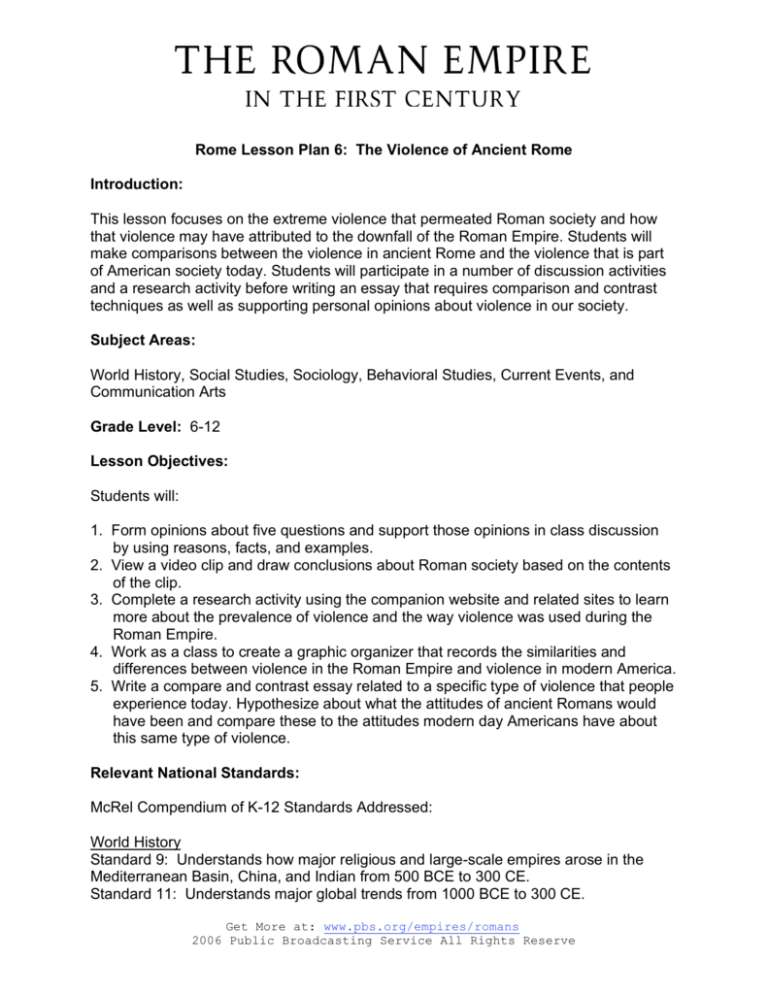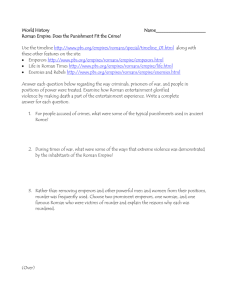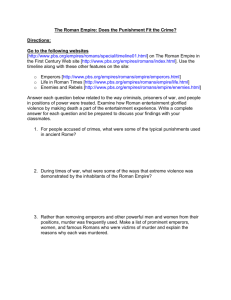
Rome Lesson Plan 6: The Violence of Ancient Rome
Introduction:
This lesson focuses on the extreme violence that permeated Roman society and how
that violence may have attributed to the downfall of the Roman Empire. Students will
make comparisons between the violence in ancient Rome and the violence that is part
of American society today. Students will participate in a number of discussion activities
and a research activity before writing an essay that requires comparison and contrast
techniques as well as supporting personal opinions about violence in our society.
Subject Areas:
World History, Social Studies, Sociology, Behavioral Studies, Current Events, and
Communication Arts
Grade Level: 6-12
Lesson Objectives:
Students will:
1. Form opinions about five questions and support those opinions in class discussion
by using reasons, facts, and examples.
2. View a video clip and draw conclusions about Roman society based on the contents
of the clip.
3. Complete a research activity using the companion website and related sites to learn
more about the prevalence of violence and the way violence was used during the
Roman Empire.
4. Work as a class to create a graphic organizer that records the similarities and
differences between violence in the Roman Empire and violence in modern America.
5. Write a compare and contrast essay related to a specific type of violence that people
experience today. Hypothesize about what the attitudes of ancient Romans would
have been and compare these to the attitudes modern day Americans have about
this same type of violence.
Relevant National Standards:
McRel Compendium of K-12 Standards Addressed:
World History
Standard 9: Understands how major religious and large-scale empires arose in the
Mediterranean Basin, China, and Indian from 500 BCE to 300 CE.
Standard 11: Understands major global trends from 1000 BCE to 300 CE.
Get More at: www.pbs.org/empires/romans
2006 Public Broadcasting Service All Rights Reserve
Historical Understanding
Standard 2: Understands the historical perspective.
Behavioral Studies
Standard 1: Understands that group and cultural influences contribute to human
development, identity, and behavior.
Standard 4: Understands conflict, cooperation, and interdependence among
individuals, groups, and institutions.
Language Arts
Writing
Standard 2: Uses the stylistic and rhetorical aspects of writing.
Standard 3: Uses grammatical and mechanical conventions in written compositions.
Standard 4: Gathers and uses information for research purposes.
Reading
Standard 5: Uses the general skills and strategies of the reading process.
Standard 7: Uses reading skills and strategies to understand and interpret a variety of
informational texts.
Listening and Speaking
Standard 8: Uses listening and speaking strategies for different purposes.
Thinking and Reasoning
Standard 1: Understands the basic principles of presenting an argument
Standard 3: Effectively uses mental processes that are based on identifying similarities
and differences.
Working with Others
Standard 4: Displays effective interpersonal communication skills.
Estimated Time:
This should take two 90-minute class periods or three 50-minute class periods, plus
additional time for extension activities.
Materials Needed:
• Video clips necessary to complete the lesson plan are available on The Roman
Empire in the First Century Web site
[http://www.pbs.org/empires/romans/index.html]. If you wish to purchase a copy of
the program, visit the PBS Shop for Teachers [Purchase DVD or Video].
• Internet access for conducting research activities.
Get More at: www.pbs.org/empires/romans
2006 Public Broadcasting Service All Rights Reserve
•
Does the Punishment Fit the Crime? [Download PDF here (200k)], activity, which is
part of this lesson plan.
Procedures:
1. To get students interested in the lesson, ask students to number a piece of scratch
paper from one to five and answer each question by writing the word Agree or
Disagree next to the corresponding number. Students should be ready to discuss
their answers. Read each of the questions below and give students time to write
their response to each question.
•
•
•
•
•
When people repeatedly view violence in different forms of entertainment, they
become hardened to it and are not upset by it.
Playing violent video games and watching television programs or movies with
extreme violence is just a leisure activity and not something that can desensitize
people to violence.
We glorify violence in our country.
Societies that glorify violence and accept it as a form of entertainment are
barbaric and uneducated.
Violence begets violence, and if you watch it you will want to behave in a similar
manner.
2. Take time to discuss and debate the answers to each of the questions above. Allow
students time to voice their opinions about why they agreed or disagreed with each
statement, and encourage them to provide specific examples to support their
arguments.
3. Close the discussion by introducing what many people considered a very violent
society – the ancient Romans. Explain that while the Roman Empire was
undoubtedly one of the most powerful and technologically advanced and literate
societies of its time, it was also one of the most violent. Bring up the fact that one
reason cited for the fall of Rome is the decline of morals and values, among other
things. Demonstrate this by having students view the video clip Episode 4:
Entertainment Roman Style [insert pbs video link]. Discuss what made this form of
entertainment especially violent.
4. Using content from the Timeline
[http://www.pbs.org/empires/romans/special/timeline01.html] and the Virtual Library
[http://www.pbs.org/empires/romans/special/library.html] on The Roman Empire in
the First Century Web site [http://www.pbs.org/empires/romans/index.html], have
students complete the Does the Punishment Fit the Crime? [Download PDF here
(200k)] activity.
5. Discuss the activity and ask students to explain their answers using reasons, facts,
and examples to support what they say.
Get More at: www.pbs.org/empires/romans
2006 Public Broadcasting Service All Rights Reserve
6. As a class, discuss violence in the U.S. using questions such as those listed below.
A graphic organizer such as a Venn Diagram or T-chart could be used to record
similarities and differences between the ancient Romans and modern-day
Americans.
•
•
•
•
What type of violence-based leisure activities do Americans participate in and/or
support?
What does our support of these types of activities say about our country’s
attitude toward violence?
In ancient Rome, the death penalty was common for criminals, prisoners of war,
and for people in positions of power. In what ways does our society mirror the
ancient Romans when it comes to these three areas? How is our society
different?
Murder was common in ancient Rome, regardless of social class. Do you think
the same could be said about American society? Why or why not?
7. Many lessons can be learned from the behavior of the ancient Romans. While few
except the scholars and writers of the time seemed opposed to the level of violence
in ancient Rome, it was ultimately a contributing factor in the downfall of the Roman
Empire. Examine American culture and the way people in the U.S. view violence
against one another. Choose a topic such as:
•
•
•
•
•
•
•
•
The death penalty
The sale of violent video games
The sale of violent music
Violent television programming (including certain sporting events)
The violent crime rate in the U.S.
The American prison system
Violence in U.S. schools
Gang violence
Write a one to two page essay that examines the similarities and differences
between American attitudes about this type of violence and what the Roman attitude
may have been. In what ways do the two societies seem to share a common belief?
How do the two societies differ when it comes to these topics? How do you think
American society will be affected in the long term by the violence that is part of our
daily lives? What can be done to prevent violence from causing the downfall of
America, or is this even a possibility? Discuss your opinions and support them with
as many specific reasons, facts, and examples as you can provide.
Get More at: www.pbs.org/empires/romans
2006 Public Broadcasting Service All Rights Reserve
Assessment Suggestions:
1. Assign completion grades for the Procedures step one activity.
2. Students could earn points or participation grades for class discussion activities.
3. An accuracy grade could be assigned for completion of the Does the Punishment
Fit the Crime? activity.
4. An accuracy grade or scoring guide could be used to evaluate the essays from
Procedures step seven.
Extension Activities:
1. Work with students to create a public awareness campaign about the negative
effects of violence in your community or school. Work to encourage people to seek
peaceful resolutions to their problems through the production of posters and public
service announcements that promote a peaceful resolution to conflicts.
2. Invite the school counselor and/or a local youth counselor into the classroom to
discuss violence and youth. Have students prepare questions about the topic in
advance and provide them with the opportunity to “ask the experts” about the effects
of violence on individuals and whole societies.
3. Encourage students to write to their local, state, or national legislators regarding
issues related to violence. This could include things such as the death penalty, gun
control laws, mandatory sentencing for violence offenders, the regulating of sales of
violent entertainment/media products, etc. Have students state their opinions about
what legislators should be doing to curb violence in America and make all citizens
safer.
Related Resources:
The Games section [http://www.roman-empire.net/society/soc-games.html] on the
Roman Empire Web Site [http://www.roman-empire.net/%5D
describes chariot racing and gladiators in detail.
The Romans Web pages [http://www.iol.ie/~coolmine/typ/romans/intro.html]
have features on Roman entertainment and the Roman theater. They describe several
violent aspects of both.
Get More at: www.pbs.org/empires/romans
2006 Public Broadcasting Service All Rights Reserve









